

January 7-8, Paris, France
In order to make the wedding ceremony more meaningful for our guests, we have prepared a summary of the traditions which will take place. As with most religious ceremonies, there can be different interpretations given, or emphasis placed, on a particular custom or practice. This is because while most traditions have their origin in biblical interpretation, the customs and practices with which they are associated have evolved orally over many centuries.
Different meanings or ways of doing things may reflect where a ceremony takes place; for example in a reform, conservative or orthodox synagogue. The Rabbi who leads the congregation of a synagogue will generally favour traditions which reflect his:her preferences or beliefs. Traditions can also vary according to the culture of a given Country in circumstances where Jewish and National customs may have fused over time.
The Kala (Bride) will wait in a private room with a close friend(s) or family member(s).The Hatan (Groom) and the two families will mingle with the invited guests. There will be 3 French flower girls; Sandrine, Delphine and Beatrice (Daniel's nieces) who will walk around with " les paniers de la quete" or flower baskets. They will ask guests to make a small money donation for needy families. This is a French Jewish tradition which is thought to have been adapted from a similar custom which takes place in Catholic churches.
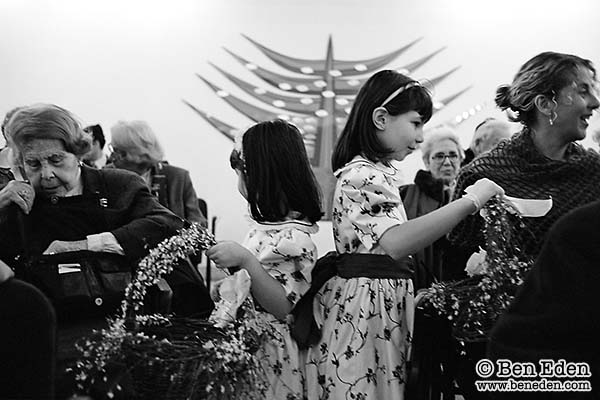
Just prior to the ceremony, the groom will be called into a separate room to accept the conditions of the Ketubah or Jewish marriage contract in the presence of his close family and witnesses. It is at this time that the two witnesses sign the Ketubah. The Ketubah is written in Aramaic and details the husband's obligations to his wife; food, clothing, dwelling and pleasure. It also creates a lien on all of the husband's property to pay the wife a sum of money in the event that he either divorces or predeceases her. The document is witnessed by two people of Jewish origin and has the standing of a legally binding agreement. It is enforceable in certain countries by secular law though not in France. In most Western countries, the civil law will afford greater protection to a woman in the event of divorce. The Ketubah is often written as an illuminated manuscript and some are regarded as fine works of art.
Jewish wedding ceremonies are comprised of two distinct ceremonies; the betrothal (kiddushin) and the nuptials (nissuin). A noteworthy aspect of the Jewish wedding ceremony is that the bride and groom consecrate themselves to each other, whereas in Christian ceremonies it is the priest or minister who consecrates the marriage.
The music will begin and Daniel will enter the room accompanied by both his mother and father to a polish wedding march and proceed to stand under the Chuppah.
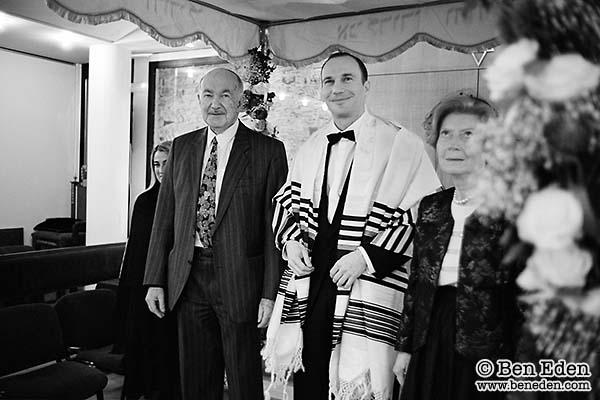
The order of a procession can vary and is not important to the law, however there is a requirement that the groom arrive under the Chuppah before the bride. A Chuppah is a canopy or decorated piece of cloth attached to the top of 4 poles which is the symbolic home for the new couple. The word means "covering or protection". The chuppah symbolises the groom's home and the bride's new domain and is the decisive act which actualises the couple's marriage. It also symbolises the bridal chamber where the marital act was consummated in ancient times.
Jana will then enter the room to a Russian wedding piece called les flots de la Volga (the waves of the Volga- Europe's largest river) with her face covered by a veil accompanied by both her mother and father. She will stand a short distance from the chuppah and wait for Daniel to step down from under from the chuppah to lift the veil from her face.
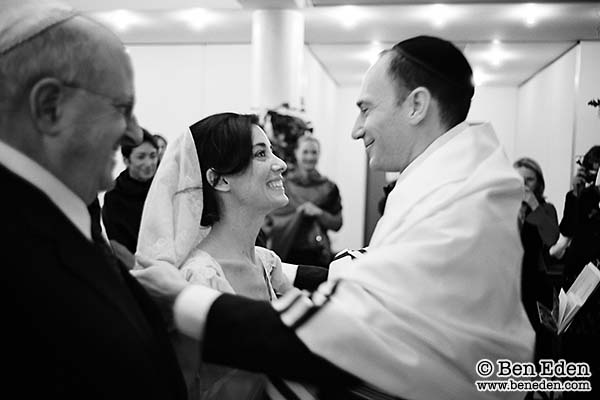
The wearing of a veil has been given a number of interpretations which can be summarised as follows: - It is the symbol of the married woman; - It is the symbol of a new unapproachability to others; - It represents modesty; - It is considered a way for the groom to confirm that the person he is in fact marrying is his bride! (story in the book of Genesis about Jacob marrying Leah instead of Rachael because he was tricked by his father into doing so)
Daniel will return to the chuppah and then Jana's parents will walk with her to join him and his parents under the Chuppah. Jana will then circle Daniel 3 times. The custom of the bride circling the groom is also open to several interpretations. The one that we favour is that it symbolises the idea of the bride being a protective, surrounding light of the household that illuminates it with love from within and protects it from harm from the outside. While circling the groom 3 times has become accepted tradition over the years, the original custom required 7 circles to reflect the seven days of creation. The symbolism is that the bride and groom are about to create their own "new world" together.
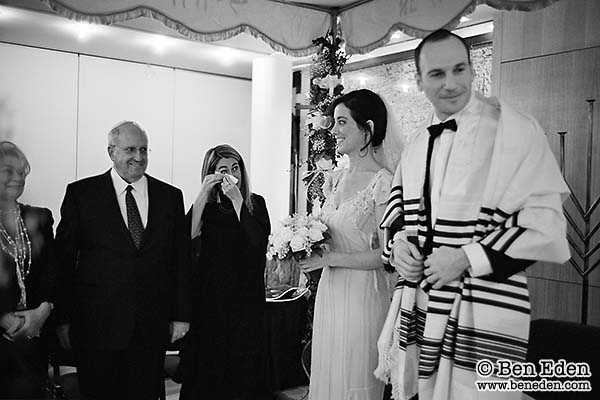
Once Jana has circled Daniel, she will stand to his right under the Chuppah. It is customary in some countries, such as the United States, that all participants under the Chuppah remain standing throughout the ceremony except for the infirm and aged. During French Jewish weddings, the custom is for everyone under the chuppah to both stand and sit according to what is taking place during the ceremony. There is no requirement that the bride and groom face any particular direction, though preferences do vary. For instance, in Hassidic weddings the couple will face the wedding guests whereas in many American weddings it is accepted practice that they face the rabbi in a demonstration of the personal component of the public celebration. Our Rabbi asks that everyone under the chuppah face the guests so they are able to witness what is occurring during the ceremony.
Our Rabbi will then give a speech which will include a brief history of how Daniel and Jana met and some of the many reasons they have chosen to marry. The Rabbi will speak in both French and English.
The first blessing over the wine will then take place. Both the bride and groom drink from the cup. One reference suggests that wine is symbolic of life and that it also symbolises the overflowing of Divine blessing as in the verse in Psalms " my cup runneth over".
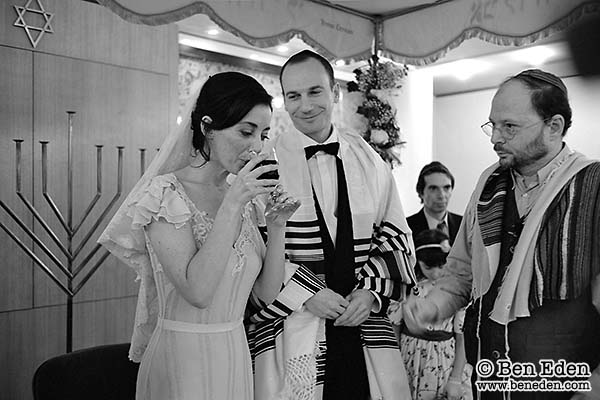
Jill, my maid of honour, will then hand the ring to the Rabbi who will show it to the witnesses and then hand it to Daniel. Daniel will then hold Jana's ring and say before the witnesses in Hebrew, and English " By this ring, you are betrothed to me according to the law of Moses and Israel."
Daniel will then place a plain gold ring on Jana's finger. The ring must be plain with no precious stones. One interpretation of this tradition says that this is to avoid any possible deceit by the groom; for example using costume jewellery which the bride may believe is real! Jewish law unequivocally states that the ring is a money equivalent and represents one of the three so called acts of acquisition practiced by the groom. The ring must belong to Daniel and is to be placed on Jana's index finger. This is because the index finger is more visible thus enabling Jana to show the witnesses that she received the ring!
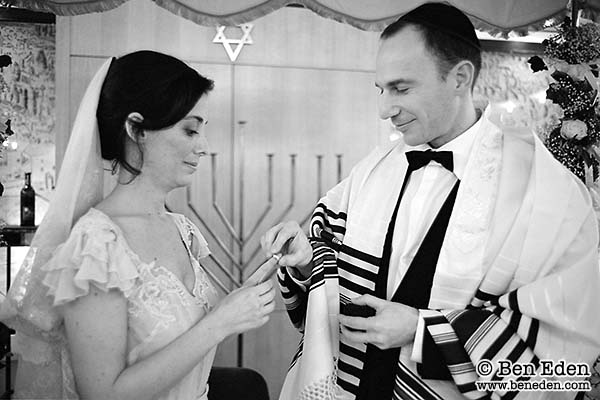
Then the Rabbi will do a public reading of part of the Ketubah or marriage contract. Daniel will then sign it and hand it to Jana.
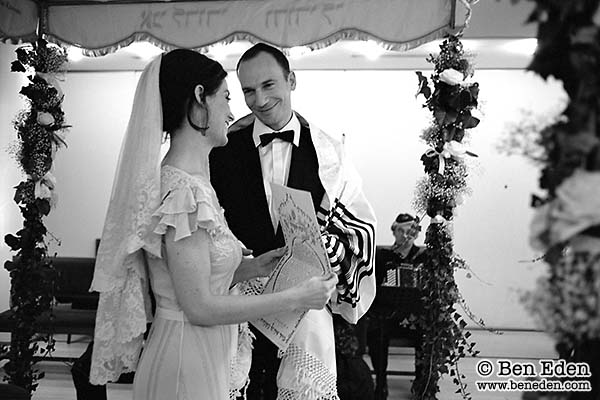
Then Jana will place a ring on Daniel's finger and say in Hebrew "Ani le-dodi ve-dodi li" which in English means " I am one with my fiancee and he is one with me".
The seven blessings or sheva brachos are now recited over the second cup of wine. The theme of these blessings links the bride and groom to the Jewish faith in G-d as creator of the world, bestower of joy and love and the ultimate Redeemer of the Jewish people. The fathers of the groom and bride will each recite one of the 7 blessings. At this time Daniel will also cover Jana with his Talith or prayer shawl. Then there is more drinking as the glass of wine is passed around to all those under the chuppah.
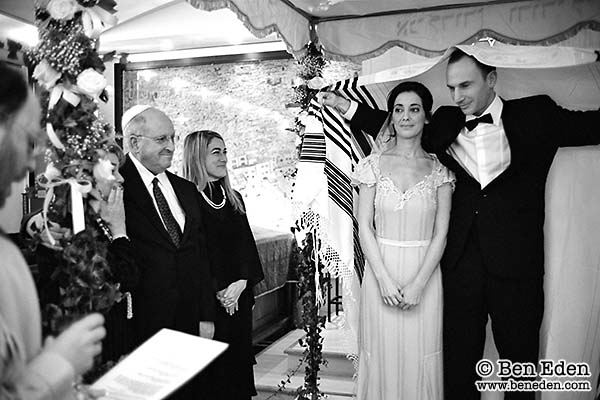
Finally Daniel will break a glass of wine by stepping on it. This custom dates back to Talmudic times and symbolises the sadness felt by the Jewish people by the destruction of the Temple of Jerusalem in ancient times. This custom is also intended to unite the bride and groom with the spiritual and national destiny of the Jewish people. This tradition differs in Israel where the glass is broken earlier in the ceremony prior to the reading of the marriage contract.
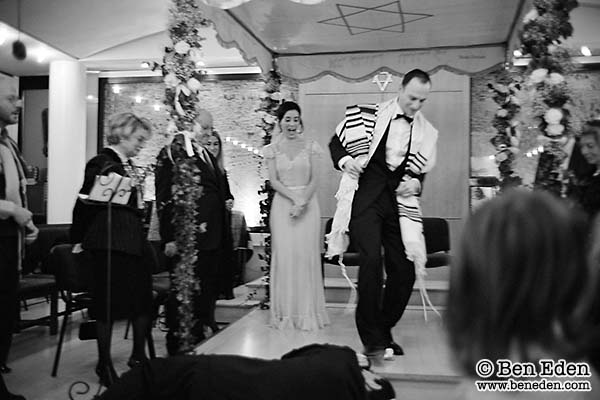
The breaking of the glass marks the conclusion of the ceremony and everyone will shout "Mazel Tov" which in Hebrew means "Good luck" or "congratulations". Klezemar music will then be played. In Hebrew, the word "Klej" means instrument and the word "zemer" means song. Klezemar is the traditional folk music of Eastern European Jews which originated in the 19th century. It is often thought of as Yiddish music and is said to touch upon all of life's emotions. Like Jazz, it is considered to be performer's music as it allows musicians to improvise. It is strongly connected with the Kabbalah (system of mystical Judaism) as it is said to be able to "open heaven, bring the angels to life, and entice wishes and prayers directly into G-d's ear".
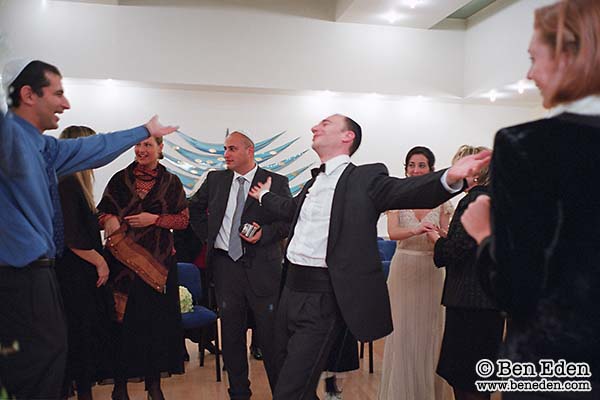
Before leaving the synagogue for the reception, Daniel and Jana will be accompanied to the cheder yichud or "room of privacy". This is to enable them to be alone in a closed room together; an intimacy reserved only for a married couple! The fact that they are alone together in a closed room is a requirement of the legal act of marriage and must be observed by the two witnesses of the marriage.
According to an American idea of what is Reform, Conservative or Orthodox, our synagogue is most equivalent to a Conservative synagogue. It is therefore a mark of respect for women to cover their shoulders and for men (even non-Jewish men) to wear a kippah (Hebrew) or skullcap while in the synagogue. The act of covering one's head in a synagogue is to show respect for G-d. Our Synagogue will provide Kippahs for male guests or, alternatively, men can simply wear a hat or baseball cap.
|
Please note that all photographs and content on this website are ©2006 Ben Eden Photography. All rights are reserved. You are only entitled to view the images in your web browser. Any other use without prior written permission constitutes a copyright violation. |